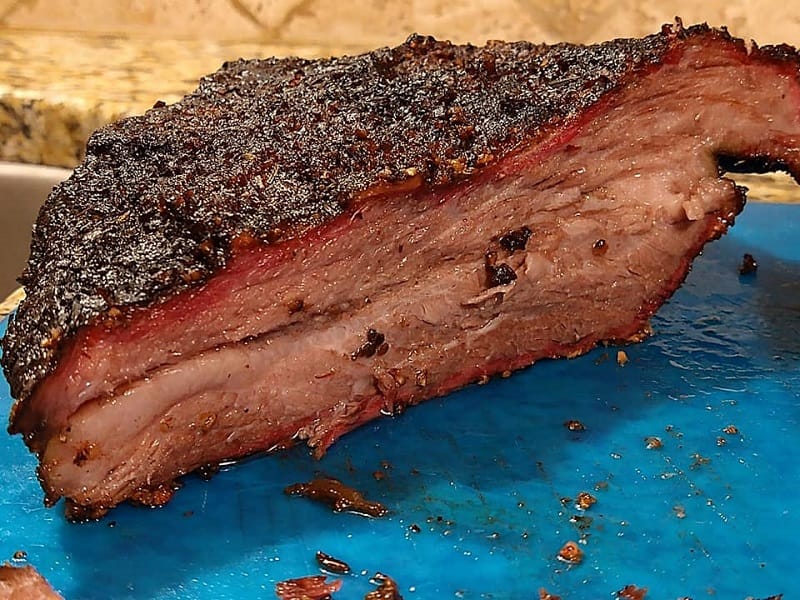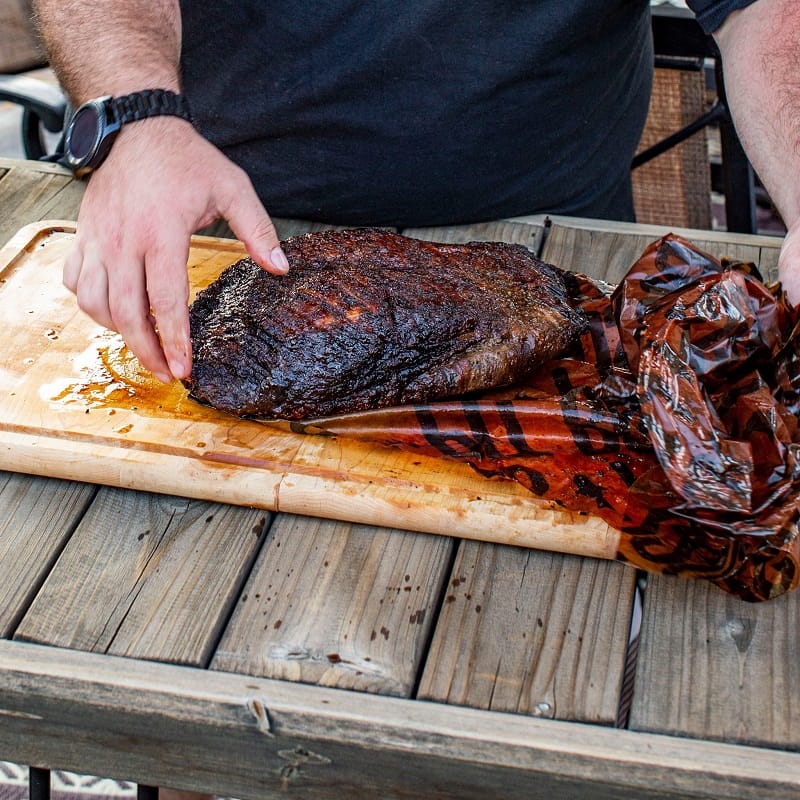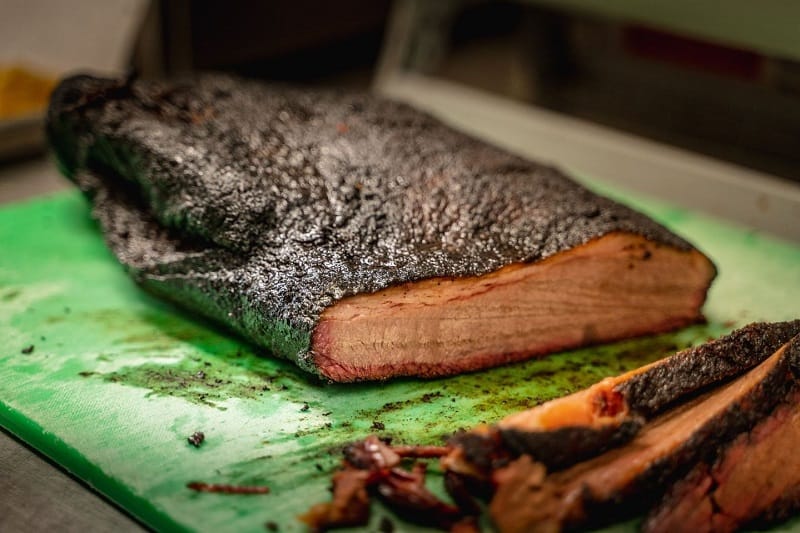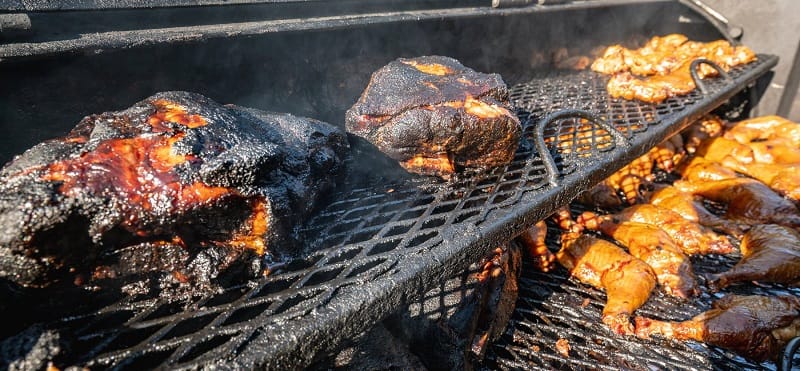Smoking brisket is one of the most popular ways to enjoy succulent and tender meat. But, finding the perfect temperature for smoking can be a tricky task. Smoking brisket at 250 vs 225 is two very different experiences, each offering its unique flavor. While there’s no one-size-fits-all answer, exploring the differences between these two temperatures can help you decide which one is best. In this article, we’ll discuss the pros and cons of smoking brisket at 250°F versus 225°F, so you can determine what temperature will give your brisket just the right flavor.
Understanding the Ideal Temperature for Smoking Brisket

When it comes to smoking brisket, one of the most important aspects of the entire process is understanding the ideal temperature for smoking. Finding the right temperature to smoke your brisket can make a huge difference in the texture and flavor of your meat. Here’s what you need to know about finding the right temperature for smoking your brisket.
First, it’s important to understand that the ideal temperature for smoking brisket is between 210 and 230 degrees Fahrenheit. This range ensures that the meat’s fat and connective tissues break down and cook evenly. If you smoke your brisket at a temperature below 210 degrees, the fat and connective tissues won’t break down properly, resulting in a tough, dry texture. If you smoke your brisket at a temperature above 230 degrees, the fat will melt away, and the meat can become too tender.
Use an oven thermometer or a digital thermometer to ensure that you’re smoking your brisket at the optimal temperature. Place the thermometer inside the smoker and the brisket and monitor the temperature throughout the smoking process. Adjust the temperature as needed to keep your brisket in the ideal range.
When you’re ready to take your brisket off the smoker, use an instant-read thermometer to check the internal temperature of the meat. The internal temperature should be between 195 and 205 degrees Fahrenheit. Once your brisket has reached the desired internal temperature, it’s time to let it rest. Place the brisket in an empty cooler and cover it with a few towels. Let the brisket rest for at least one hour before slicing and serving.
Understanding the ideal temperature for smoking brisket is essential for achieving the perfect texture and flavor. Start with the right temperature, and don’t forget to use a thermometer to monitor the progress. With the right temperature and patience, you’ll be able to enjoy a delicious smoked brisket in no time.
The Benefits of Smoking at 250°F
Smoking meat at a temperature of 250°F offers a variety of benefits. This method is especially beneficial for cuts like brisket and pork butt, which are large and need to be cooked for longer periods of time at lower temperatures. Humidity is also a key factor inside smokers, as it helps to ensure that the meat retains its moisture during the cooking process. Smoking at 250°F also creates a flavorful, smoky taste that can’t be achieved at higher temperatures. Finally, cooking at this temperature allows for shorter cooking times, meaning you can enjoy your meal sooner.
The Benefits of Smoking at 225°F
Smoking meat at 225°F has many benefits. It allows the meat to cook slowly, creating a flavor profile unique to smoking. The smoke has better retention at this temperature, and the beef experiences less shrinkage and moisture loss. Additionally, the cooking time is reduced compared to other temperatures, meaning the food can be prepared more quickly. Smoking at 225°F is also recommended for poultry at a higher temperature of 325°F, ensuring that it is cooked through. This low and slow cooking method ensures the meat is cooked safely, as the finished meat temperature should be 160°F. Overall, smoking at 225°F can provide a delicious flavor profile and reduce cooking time, making it a great choice for any barbecue style.
The Difference Between Smoking Brisket at 250 vs 225

The debate of whether brisket should be cooked at 225°F or 250°F is still ongoing. Generally, those in favor of smoking at 250°F argue that the rendered fat from the brisket has a better texture than when cooked at a lower temperature. Those who favor smoking at 225°F believe slow cooking makes for more tender and moist meat.
However, the difference in internal temperature between 225°F and 250°F is huge. Heat transfer rates are proportional to temperature, meaning that the brisket will cook faster at a higher temperature. A 15-pound shoulder has been estimated to take 10 hours to cook at 250°F, while at 225°F, it would take longer. The benefits of smoking at 250°F would be that your meat will cook through faster and save you a few hours of cooking time. The drawbacks are that it might not be as tender and moist as it would be if cooked at 225°F.
Ultimately, the ideal smoker temperature for different times and temps to cook from rare to well done is a consistent 225 to 250 °F across all methods.
Does The Cooking Time Differ Significantly Between 250 And 225 Degrees?
The higher temperature of 250 degrees will cook food faster than the lower temperature of 225 degrees. Generally, increasing the temperature by 25 degrees will cut the cooking time in half. Therefore, it will take around twice as long to cook food at 225 degrees compared to 250 degrees.
How Long to Smoke Brisket at 225 Degrees
Smoking a brisket at 225 degrees Fahrenheit is considered the optimal temperature for cooking. Generally, the cooking time is around 1.5 to 2 hours per pound. For example, a 10 lb brisket should be smoked for about 15 to 20 hours. The internal temperature should be reached at around 203 degrees Fahrenheit. Depending on the smoker and type of brisket, the cooking time can vary slightly.
How Long to Smoke Brisket at 250 Degrees
When smoking brisket at 250 degrees Fahrenheit, it is recommended to plan for 60-90 minutes per pound. The lower temperature helps to ensure that the brisket is cooked thoroughly and evenly. Generally, a 12-pound brisket will take 10-15 hours to cook, depending on the smoker and the desired level of doneness. Additionally, the internal temperature should be monitored closely as the brisket is cooking, as it should reach 195°F to 203°F when done.
Is It Better to Smoke Brisket at 225 or 250?

It is generally accepted that smoking brisket at a lower temperature of 225 degrees Fahrenheit produces a more tender and juicy finished product. However, smoking at a higher temperature of 250 degrees Fahrenheit is also an option that can reduce cooking time and render the soft fat in the brisket. Ultimately, deciding whether to smoke brisket at 225 or 250 degrees Fahrenheit depends on personal preference. For those who prefer a smokier flavor, a lower temperature is recommended. A higher temperature would be better for those who like a juicy steak.
See more:
How Does The Smoke Flavor Vary When Using These Two Different Temperatures?
The smoke flavor of meat can vary greatly when using different temperatures for smoking. When using 250 degrees, the smoke flavor will be more intense and penetrate deeper into the meat. On the other hand, smoking at 225 degrees will result in a milder and less intense smoke flavor. The lower temperature also tends to bring out more of the meat’s natural flavors, as the smoke isn’t overpowering the taste.
How To Know When the Brisket Is Done
There are a few different ways to tell when your brisket is done. The most reliable way is to use a meat thermometer. You’ll want to insert the thermometer into the thickest part of the brisket and check the temperature. A fully cooked brisket should register at least 165°F. This is the temperature recommended by the USDA for food safety.
Another way to tell when a brisket is done is to use the “poke test.” To do this, press your finger into the thickest part of the brisket. The brisket is done if it feels like your finger is pressing into a soft, spongy surface.
Finally, you can also look for what’s known as the “bark.” This is the dark, crusty layer of fat and spices on the surface of the brisket. When the bark is dark brown, and it’s starting to flake off, then the brisket is done.
No matter how you check, ensure you use a clean and sanitized thermometer or utensil. You don’t want to introduce any bacteria into your meat.
Cooking a brisket can be intimidating, but with the right tools and knowledge, you can make sure your brisket is cooked to perfection. Remember to check the temperature, use the poke test, and look for the bark. With these tips, you can tell when your brisket is done and enjoy it to the fullest.
How to Achieve Maximum Tenderness with Brisket
1. Start with Quality Meat
As with any dish, the quality of the ingredients will make or break the end result. When looking for the right brisket cut, choose a piece with a good layer of fat and a fair amount of marbling. The fat will render during the cooking process, creating a rich and flavorful piece of meat.
2. Trim the Fat
Trim the fat off the brisket before cooking. The fat will add flavor to the meat, but too much of it can create an overly greasy texture. Aim to leave a thin layer of fat on top, but remove any large chunks.
3. Dry Brine the Meat
Once you’ve trimmed the fat off the brisket, it’s time to dry-brine it. Dry brining is a simple process that involves rubbing a mixture of salt, pepper, and other seasonings onto the meat before cooking. This will help the brisket develop an even flavor and juicy texture.
4. Use a Low and Slow Cooking Method
Brisket is a tougher cut of meat that requires low and slow cooking methods to become tender. Cooking the meat at a low temperature over a long period of time will help break down the connective tissues and make the meat more tender. Try using a slow cooker or a smoker to create a moist and tender brisket.
5. Let the Meat Rest
Once the brisket is cooked, it’s important to let it rest before slicing. This will allow the juices to redistribute throughout the meat and create a more tender texture. Let the brisket rest for at least 30 minutes before slicing.
By following these tips, you’ll be able to achieve maximum tenderness with your brisket. Whether serving it with classic Texas-style barbecue sauce or creating a unique dish, these tips will help you make an incredibly delicious and tender piece of meat.
Different Ways to Smoke a Brisket

Here are some popular methods: the Texas Crutch, The oven, Indirect heat, The Sous Vide Method, Reverse Sear, and Low and Slow.
- The Texas Crutch is one of the most popular methods for smoking a brisket. It involves wrapping the brisket in aluminum foil or butcher paper after a few hours of smoking. This creates a steamy environment that helps to speed up the cooking process and helps to keep the brisket moist. This method is great for those who are short on time or are looking for a tender, juicy brisket in a short amount of time.
- The Reverse Sear method is the opposite of the Texas Crutch. After smoking for a few hours, the brisket is removed from the smoker and placed in a hot oven or on a hot grill until the internal temperature reaches the desired level. This method helps to create a beautiful, crispy bark on the outside of the brisket while still keeping inside tender and juicy.
- Next up is using indirect heat. This method still uses a smoker, but you won’t use direct heat from the coals or wood. Instead, you’ll be using a heat diffuser to create indirect heat. This method is a great way to get a smoky flavor without worrying about the potential flare-ups from the direct heat.
- You can also smoke your brisket in an oven. This is a great way to get that smoky flavor without smoking. To do this, you’ll want to preheat your oven to 250 degrees. Then, place the brisket in a baking dish and cover it with aluminum foil. Place the baking container on the middle rack of the oven and bake for approximately three hours, or until the brisket’s internal temperature reaches 165 degrees.
- The Sous Vide method is excellent for those who enjoy a tender and juicy cut of meat with minimal effort. You’ll need a sous-to-vide machine and a large pot of water to do this. Once the water is heated to the desired temperature, you’ll need to place the brisket in the machine and set the timer. Once the timer is done, you’ll need to remove the brisket and finish it off in the smoker.
- Finally, the Low and Slow method is the traditional way to smoke a brisket. This involves smoking the brisket at a low temperature (around 225°F) for a long period of time (up to 16 hours). This method requires more time, but it’s worth it if you’re looking for a super juicy and tender brisket.
FAQs
The Best Temperature for Rendering Soft Fat in Brisket?
The best temperature for rendering soft fat in brisket is between 130-140°F. This is the temperature where fat begins to dissolve and render, and it is necessary for the collagen to break down and for the brisket to develop its full flavor. At this temperature, fat liquefies and continues to do so for several hours as long as the temperature is maintained below 190°F. It is important that the smoker is set to 250°F for slowly rendering fat, as higher temperatures will cause it to vaporize. Additionally, low temperatures of 215-225°F and longer cooking times are necessary to melt the fat.
Why High-Temperature Cooking is Preferred for Juicy Meat
High-temperature cooking is preferred for juicy meat because it helps break down the tough muscle fibers and collagen in the meat. At temperatures above 140°F (60°C), the meat will begin to contract, and moisture will be released. This moisture helps to keep the meat tender, juicy, and flavorful.
Are Any Specific Cuts Of Meat Better Suited To Being Smoked At A Particular Temperature Range (250 Vs. 225)?
Yes, specific cuts of meat are better suited to being smoked at a particular temperature range. For example, brisket and pork shoulder are best smoked at a lower temperature of 225°F, while ribeye and pork loin can be cooked at higher temperatures like 250°F. Brisket and pork shoulder require a longer cooking time to become tender and juicy, so the lower temperature helps keep the meat from drying out. Ribeye and pork loin are leaner cuts of meat, so they do not require as much time to achieve the desired doneness. Therefore, the higher temperature helps them cook faster.
How Does Meat Weight Affect Cook Time?
The weight of the meat does not significantly affect the cooking time. The thickness of the meat, however, is the key factor for determining how long it will take to cook. Higher cooking temperatures will result in greater shrinkage as moisture evaporates and the meat begins to shrink. Cooking the meat past medium or 140°F will result in the most significant reduction in weight and size. Shorter cooking times will result in less moisture loss, and cooking steaks for longer than four hours can produce an undesirable “mouth feel.” Weighing the meat raw and recording the appropriate values (based on the nutrition information) is a helpful way to monitor the changes in size during cooking.
How Do You Maintain A Consistent Temperature When Smoking Brisket At 250 Or 225 Degrees?
To maintain a consistent temperature when smoking brisket at 250 or 225 degrees, it is essential to invest in a quality smoker. Place the smoker in a sheltered area to help protect it from the wind and adjust the air temperature inside it. This means adjusting the air intake vent, exhaust vent, and/or the damper. You can also adjust the heat source itself, such as by adding or reducing charcoal or wood.
It’s also important to use an appropriate amount of wood or charcoal. The amount of fuel used to smoke the brisket will affect the temperature. For example, if you add too much fuel, the temperature will be too hot, and if you add too little, the temperature will be too low.
Another way to maintain a consistent temperature is to use a water pan. Place a large pan of water on the smoker’s cooking grate. This will help regulate the temperature and add moisture to the air.
Finally, it’s important to make sure your smoker is well-insulated. If the outside of the smoker is too hot or too cold, it will affect the temperature inside the smoker. Don’t forget to set a low alarm to alert you when the temperature drops too low.
How Long Should One Rest Their Brisket After Smoking It At Either 250 Or 225 Degrees?
After smoking a brisket at either 250 or 225 degrees, it is important to let it rest for at least 2 hours. This will allow the juices to redistribute throughout the meat, resulting in a more tender, flavorful product. During the resting period, the internal temperature should remain around 160°F. After the brisket has properly rested, it can be placed in the holding chamber or served.
What Type Of Smoker Works Best For Smoking Both Cuts Of Beef At Either 250 Or 225 Degrees?
An offset smoker is the best for both cuts of beef at either 225 or 250 degrees. Offset smokers are designed to maintain a consistent temperature and reach temperatures up to 250 degrees. Furthermore, offset smokers have a lot of space for a large cut of beef such as brisket or chuck roast and are equipped with adjustable dampers to regulate the airflow and heat. To get the most out of your smoker, use wood chunks or chips to impart a smoky flavor to the meat.
Conclusion
No matter what temperature you choose, smoking brisket is an art that requires patience and practice. With the right amount of time and temperature, you should be able to create a delicious and tender brisket that will be the star of any barbecue.
We hope this post has helped answer the question of smoking brisket at 250 Vs 225; nothing is stopping you from trying this recipe today!

Hey readers! Chip Holland here, and I’m a Manager of this website. My passion for writing about it only matches my passion for BBQ. Follow my blog for mouth-watering recipes, tips, and tricks for the perfect smoke, grill, and BBQ. I’m sure you won’t be disappointed!
